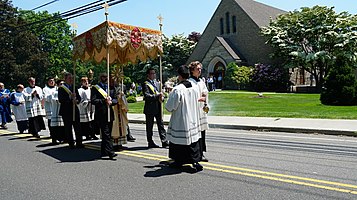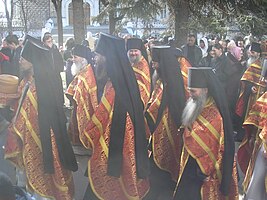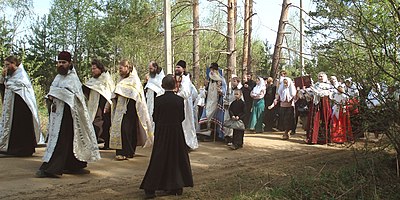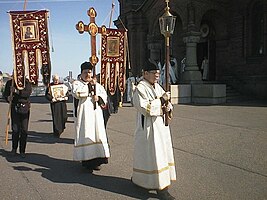Procession
A procession is an organized body of people walking in a formal or ceremonial manner.[1]

History
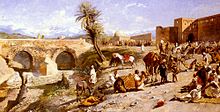
Processions have in all peoples and at all times been a natural form of public celebration, as forming an orderly and impressive ceremony. Religious and triumphal processions are abundantly illustrated by ancient monuments, e.g. the religious processions of Egypt, those illustrated by the rock-carvings of Boghaz-Keui, the many representations of processions in Greek art, culminating in the great Panathenaic procession of the Parthenon Frieze, and Roman triumphal reliefs, such as those of the arch of Titus.[1]
Greco-Roman practice
Processions played a prominent part in the great festivals of Greece, where they were always religious in character. The games were either opened or accompanied by more or less elaborate processions and sacrifices, while processions from the earliest times formed part of the worship of the old nature gods, as those connected with the
The most prominent of the Roman processions was that of the Triumph, which had its origin in the return of a victorious army headed by their general, who accompanied by the army, captives, spoils, the chief magistrate, priests bearing the images of the gods, amidst strewing of flowers, burning of incense and the like (Ovid, Trist. iv. 2, 3 and 6), proceeded in great pomp from the Campus to the Capitol to offer sacrifice.
Connected with the triumph was the pompa circensis, or solemn procession that preceded the games in the circus. It first came into use at the Ludi Romani, when the games were preceded by a great procession from the Capitol to the Circus. The praetor or consul who appeared in the ponipa circensis wore the robes of a triumphing general (see Mommsen, Staatsrec/zt I. 397 for the connection of the triumph with the ludi). Thus, when it became customary for the consul to celebrate games at the opening of the consular year, he came, under the empire, to appear in triumphal robes in the processus consularis, or procession of the consul to the Capitol to sacrifice to Jupiter.[1]
Christian practice

Early
After the ascendency of Christianity in the Roman Empire, the consular processions in Constantinople retained their religious character, now proceeding to Hagia Sophia, where prayers and offerings were made; but in Rome, where Christianity was not so widely spread among the upper classes, at first the tendency was to convert the procession into a purely civil function, omitting the pagan rites and prayers, without substituting Christian ones.[2]
Only after Theodosius did the processions become a religious event, replete with icons, crosses, and banners. There were other local processions connected with the primitive worship of the country people, which remained unchanged, but they were eventually overshadowed by the popular piety of the
For the processions that formed part of the ritual of the
Very early were the processions accompanied by hymns and prayers, known as
Some liturgists maintain that the
In times of calamity litanies were held, in which the people walked in robes of penitence, fasting, barefooted, and, in later times, frequently dressed in black (litaniae nigrae). The cross was carried at the head of the procession and often the gospel and the relics of the saint were carried.
Funeral processions, accompanied with singing and the carrying of lighted tapers, were very early customary (see
Festivals involving processions were adopted by the
A description of the institution and character of the Ascensiontide rogations is given by
Baroque Catholicism
The element of ritual was prominent in early modern
During the Reformation, the liturgical year was central to the liturgical practices of Catholicism. Beginning with the Christmas season (from Advent to Epiphany) and followed by the feasts of Easter, Passiontide and Pentecost , Trinity Sunday and the Feast of Corpus Christi.[24] In the early 18th century there were eleven processions of note at the village of Ettenkirch (near Lake Constance). These processions could travel to destinations as far as two hours away. Monthly processions took place around the Church, and on All Souls' Day and Palm Sunday.[23] Corpus Christi was one of the most elaborate.
One of the effects of the
Imperial China
The Story of the Stone, written in the 18th century, contains a description of the procession accompanying an Imperial Concubine:
Presently a faint sound of music was heard and the Imperial Concubine's procession at last came in sight. First came several pairs of eunuchs carrying embroidered banners. Then several more pairs with ceremonial pheasant-feather fans. Then eunuchs swinging gold-inlaid censers in which special 'palace incense' was burning. Next came a great gold-coloured 'seven phoenix' umbrella of state, hanging from its curve-topped shaft life a great drooping bell-flower. In its shadow was borne the Imperial Concubine's travelling wardrobe: her head-dress, robe, sash and shoes. Eunuch gentlemen-in-waiting followed carrying her rosary, her embroidered handkerchief, her spittoon, her fly-whisk, and various other items. Last of all, when this army of attendants had gone by, a great gold-topped palanquin with phoenixes embroidered on its yellow curtains slowly advanced on the shoulders of eight eunuch bearers.[28]
Procession elements


Many elements may be used to make a procession more significant than just "people walking in the same direction":
- A special mode of transport, such as a ceremonial automobile.
- Music, including everything from the choir of a church procession to the marching band of a military procession. Criers may march before the procession, yelling to clear the way for it. Some high school homecoming parades include trucks filled with people who do nothing but make as much noise as possible.
- Order of precedence: even without showy display, a group of people walking forward may be said to form a procession if their order and placement clearly visualize a hierarchy or symbiotic relationship. For instance, one's nearness to the king or others of high rank had important political connotations when the royal family walked to or from chapel services at the Edwardianparties progressed from the sitting room to the dining room, and the stylized movement and hierarchy of marching military units clearly sets up a formal procession.
- Bearers of ring bearerat a wedding.
- Scent, provided by flower bearers or censers of incense.
- Skilled performers, such as acrobats or dancers
- Special costume: traditionally, the costumes of George IV of the United Kingdom, carried at his coronation by nine lords in waiting with their own matching silken clothes, capes, ruffs, and plumed hats. Other examples include the Swiss Guard and high vestments of the Pope. The formal, matching clothes of bridesmaids and groomsmen are in the same tradition, although sometimes purchased at the attendant's expense rather than by the people honored in the ceremony. In egalitarian times and places, whoever has taken the time and money to put together something impressive may appear in a parade; such costumes are of course the focal point of Halloween parades such as that staged in Greenwich Village, New York. Finally, processions may be staged simply to show off the costumes as one part of a larger event, such as at fashion pageants, military reenactments, pop concerts, or Renaissance Festivals.
- Special lighting: candlelight vigils for the deceased or to show political solidarity often include a candlelit procession. Fireworks illuminate such diverse events as coronations, parades, and Thai royal barge processions.
- Spectacle, such as an aircraft ticker tape parades
- The dispensing of gifts, at one time often food or money. Today, most people are familiar with the dispensing of beads at Mardi Gras and the throwing of candy at local fair parades.
Functions of processions
Advertisement
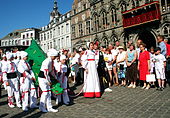
Change in government
The Reception of the Ambassadors From Siam at the
Display of power
Such as ancient Roman triumphs, the
Entertainment
Some processions are arranged for
Solidarity
Religious ceremonies have since prehistory employed the procession of holy objects to inspire solidarity of belief. The Doges of Venice once staged elaborate barge processions to bless the waters on which Venice's tightly controlled maritime economy depended.
Events

Processions used to mark the beginning or end of an event, such as parades at the beginning of
Christian processions
Processions are found in almost every form of religious worship, such as
In a narrower sense of going forth, proceeding, the term is used in the technical language of
It is impossible to describe in detail the vast development of processions during the Middle Ages. The most important and characteristic of these still have a place in the ritual of the Catholic Church, as well as those of the Church of England and the Orthodox Church.
The Procession Path (Lat. ambitus templi) is the route taken by processions on solemn days in large churches—up the north aisle, round behind the high altar, down the south aisle, and then up the centre of the nave.[30]
Catholics
For the Catholic Church, the rules governing them are laid down in the
- Processiones generales, in which the whole body of the clergy takes part.
- Processiones ordinariae, on yearly festivals, such as the Feast of Corpus Christi, in possible addition to Feast of the Ascension, Feast of the Cross, Forty Hours' Devotionand on other days, according to the custom of the churches.
- Processiones extraordinariae, or processions ordered on special occasions, e.g. to pray for rain or fine weather; in time of storm, famine, plague, war, or, in quacumque tribulatione; processions of thanksgiving; relics; or the dedicationof a church or a cemetery.
There are also processions of honor, for instance to meet a royal personage, or the bishop on his first entry into his diocese (Pontif. Tom. iii.).
Those taking part in processions are to walk bare-headed (weather permitting), two and two, in decent costume, and with reverent mien; clergy and laity, men and women, are to walk separately. The cross is carried at the head of the procession, and banners embroidered with sacred pictures in places where this is customary; these banners must not be of military or triangular shape. Violet is the prescribed colour for processions, except on Corpus Christi, or on a day when some other colour is mandated. The officiating priest wears a cope, or at least a surplice with a violet stole, while other priests and clergy wear surplices.
A Eucharistic procession is one in which the
The observance or variation of the discipline belongs to the Sacred Congregation of Rites; in pontifical processions, which are regulated by the masters of the ceremonies (magistri ceremoniarum pontificalium), these points are decided by the chief cardinal deacon. As to processions within the churches, some difference of opinion having arisen as to the regulating authority, the Sacred Congregation of Rites has decided that the bishop must ask, though not necessarily follow, the advice of the chapter in their regulation.[1]
Gallery of Catholic processions
-
The Eucharistic Procession at St. Catherine of Siena Church, Trumbull CT on the Solemnity of the Most Holy Body and Blood of Christ, Corpus Christi.
-
"passion of the Christ (since 1461), once forbidden, is still celebrated in the French southern cities and towns of Perpignan, Arles-sur-Tech and Collioure
-
Procession inSalta City, Argentina
-
Procession on the feast of the Assumption, 15 August, in Paris
-
Corpus Christi procession in Poznań, Poland, 2004: little girls carrying an Infant Jesus of Prague statue, followed by altar servers clothed in surplice and cassock
-
Painting of the Monument of Richard Stapleton in Exeter Cathedral (painting by S. A. Hart), showing a liturgical procession
-
Passion procession from Škofja Loka, Slovenia. It is shaped as a playand represents stories from the life of Jesus
-
Our Lord Jesus Christ of the Miracles procession inPonta Delgada (Azores)
-
Grand Marian Procession in Los Angeles, California, an annual tradition revived in September 2011 by the Queen of Angels Foundation, founded by Mark Anchor Albert
-
Holy Week in Seville, Spain, Royal archbrotherhood of "La Carretería"
Eastern Orthodox
Outdoors
Typically the procession commences with the phanarion (a lantern) followed by the cross,, and then the faithful. Hymns particular to the event are sung. Typically the outside of the church is circled thrice; however, some processions proceed to a designated place where a ceremony, e.g., a baptism or burial, is performed.
- Well-known processions prescribed annually include:
- Pascha (Easter) — During the Paschal Vigil at midnight on Easter Sunday.
- Bright Week Each day following at the end of the Divine Liturgy, when the Artos is carried and the paschal canonis sung.
- Great Saturday With the epitaphios carried around the church thrice, as at a priest's funeral, the choir singing the Trisagion[note 2]
- baptistry[note 3]
- patronal feastof a church, a procession around the outside of the church in conjunction with the paraklesis (prayer of intercession) to the church's namesake
- Lity— May be held outdoors with a procession
- Great Thursday — Sundry local customs
- Well-known processions for occasional events include:
- Funeral — The coffin is carried to the grave accompanied by singing of the Trisagion.[note 4]
- Consecration of a church — The relics to be placed in the altar are, after an all-night vigil, carried in solemn procession to a nearby church, placed on the altar for an early divine liturgy, and then carried in solemn procession back to the church being consecrated.[31]
Indoors
- The "Little Entrance" at the divine liturgy and at vespers
- The "Great Entrance" at the divine liturgy and, in modified form, at the divine liturgy of the presanctified gifts
- Many occasions when a bishop presides, such as:
- The meeting of bishop, when the youngest priest, all the deacons with censers, and lower clergy meet the bishop (who is escorted from his home by two subdeacons) at the western door of the church and solemnly escorted to the iconostasis and then to his throne for vesting
- Whenever a bishop censes the entire church, he is accompanied by deacons with candles and subdeacons with the dikirion and trikirion
- On Great Thursday, sundry local customs.
Gallery of Eastern Orthodox processions
-
Lity procession on the
-
procession to behind theEsphigmenou Monastery on its patron feast, the Ascension
-
pascal procession onSergiev Posad, Russia
-
Priests in the pascal procession onSergiev Posad, Russia
-
A stop for reading the Gospel and blessing with holy water during the pascal procession onSergiev Posad, Russia
-
Moscow region. May 2, 2008.
-
Finnish Orthodox procession
-
Paschal procession byMoscow region
-
Procession in Yaroslavl by Alexey Bogolyubov, 1863
-
State Tretyakov Gallery, Moscow)
-
Two-sided portable icon for a procession (A. Our Lady of Smolensk. B. Ss. Nicolas, princes Boris and Gleb) (Russia, 16th century)
-
Russian Orthodox Church procession in Kiev. 2010
-
Russian Orthodox Church procession participant in Kiev. 2010
Oriental Orthodox
Gallery of Oriental Orthodox processions
-
Saint Michael. During such processions, the clergy carry Ethiopian processional crosses and ornately covered tabots around the church building's exterior (Garland, Texas)
Reformed churches
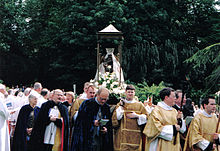
The
Liturgical processions were revived in the Church of England by the members of the Oxford Movement during the 19th century.[32] In Ritual Notes, an Anglo-Catholic liturgical manual, it is stated that "A solemn procession as part of the ceremony proper to the occasion, is ordered to be held respectively at Candlemas; on Palm Sunday; at the Rogations (i.e. on April 25th and the three days preceding Ascension); and on Corpus Christi ..." "A procession is a distinct act of worship in itself, though it is desirable (and accords with ancient practice) that it should have a definite purpose, such as to commemorate some notable event, or to honour the Blessed Sacrament".[33]
The
Processions in art

The wealth of display associated with processions makes them a rich subject for literary and visual art. Some examples include:
- Processions were popular subjects for the Finding of Moses shows an heiress of the Pharaoh proceeding to the palace with her entourage. The exotic Queen of Sheba's Visit to King Solomon by Edward Poynter touches on a longstanding convention of elaborate processions from "the East". Walter Cranedepicted Beauty being escorted by wigged monkeys in his 1874 Beauty and the Beast.
- the opera Aida is known for its triumphal procession. The first staging included a live elephant on stage.
- the processions of Tarkhaans and Tarkheenas are emblematic of Tashbaan's wealth and glamour in the book The Horse and His Boy by C. S. Lewis
In film
- elaborate Chinese wedding processions feature in the films Crouching Tiger, Hidden Dragon and The Last Emperor
- in the film Heian Period empress. In another film by the same director, Peter Greenaway, the act of Prosperosimply walking through his house becomes a lush, visual procession because of the house's wealth of literary and visual symbolism.
- the Buddha discovers death, old age, and poverty while watching an elaborate procession in the film Little Buddha
- the Nazi entourage in Raiders of the Lost Ark, upon arriving at their island base, begin an elaborate trek to the centre of the island, with soldiers holding aloft National Socialist standards. The procession is somewhat ostentatious given the climate, prompting the black-dressed Gestapo agent to remove his hat and wipe the sweat from his brow.
- the film Jefferson in Paris includes a scene during which Thomas Jefferson and his daughter watch one of the daily processions that make up the royal ritual at Versailles

- the funeral procession of Elizabeth I of England is portrayed in the film Orlando
- the triumphal procession of Helen and Paris into Troy begins the 2004 film of the same name
- a spectacular procession introduces Prince Akeem's appointed bride in the film Coming to America
- Fantasy
- a utopian parade is depicted by James Gurney in his Dinosaur Parade
- Processions appear in several Star Wars films, including award ceremonies at the end of The Phantom Menace and A New Hope, a funeral procession at the end of Revenge of the Sith, and a military procession during Return of the Jedi
- the god Ra appears in a formal procession shortly before being overthrown in the film Stargate
- the procession of Roman Holiday
- the procession of Prince Ali in the Disney film Aladdin allows the hero to show off his newfound prestige
- the procession of the wicked Skeksis into their regeneration chamber, and the following procession of their spiritual counterparts, the Mystics, marks the climax of the film The Dark Crystal
In music
- The Procession-Manchester Orchestra: where the singer tries to get over the death of someone at their funeral procession.[clarification needed][citation needed]
See also

- Cavalcade
- Funeral procession
- Parade
- Processional hymn
- Processional walkway
- Statio
- Uthsavar
- Good Friday processions in Baliuag
- March for Jesus
- List of Veiled Prophet Parade themes, St. Louis, Missouri
Footnotes
- ^ For which reason this is called in Russian: Крестный ход, Krestnyi khod, cross procession
- ^ In some traditions, a procession takes place on Palm Sunday as well.
- Lesser Blessing of Watersis performed.
- ^ If the deceased is a priest or bishop the clergy chant the Great Canon of St. Andrew
References
Citations
- ^ a b c d e f g h i j k l One or more of the preceding sentences incorporates text from a publication now in the public domain: Chisholm, Hugh, ed. (1911). "Procession". Encyclopædia Britannica. Vol. 22 (11th ed.). Cambridge University Press. pp. 414–416.
- ^ Daremberg and Saglio, Dictionnaire des Antiquités Grecques et Romaines, s.v. Consul.
- ^ See Preller, Rm. Mythologie, pp. 370-372.
- Du Cange, s.v.
- ^ Ep. IX. ad Diosc. episc. c. 445: qui nostris processionibus et ordinationibus frequenter interfuit.
- ^ Smith, Dic. of Class. Antiq. s.v. Procession.
- ^ See Louis Duchesne, Origines, 2nd ed., pp. 77, 154, 181; 78, 194.
- ^ c. 375.
- ^ c. 388, Ep. 40 16, Ad Theodos. monachos ... qui psalmos canentes ex consuetudine usuque veteri pergebant ad celebritatem Machabaeorum martyrum.
- ^ Hist. eccl. viii. 8.
- ^ Josh. vi.
- ^ 2 Sam. vi.
- ^ Origines, ch. i.
- ^ Vita S. Remig. I.
- ^ Ep. xi. 57.
- ^ See Gregory of Tours, Hist. Fr. x. i, and Johann. Diac. Vita Greg. Magn. i. 42.
- ^ See e.g. St Ambrose, Ep. 29 and St Augustine, De civitate Dei, xxii. 8 and Conf. viii. 7, for the finding and translation of the relics of Saints Gervasius and Protasius.
- ^ Alte Bittgange, in Zeller, Philosophische Aufsatze, p. 278 seq.
- ^ Fasti praenestini, C.T.L.T., p. 317.
- ^ Regist. ii.
- ^ Ep. v. 14.
- ^ Forster, Marc R. Catholic Revival in the Age of Baroque. p. 107.
- ^ a b Forster, Marc R. Catholic Revival in the Age of Baroque. p. 116.
- ^ Forster, Marc R. Catholic Revival in the Age of Baroque. p. 111.
- ^ Forster, Marc R. Catholic Revival in the Age of Baroque. p. 119.
- ^ Forster, Marc R. Catholic Revival in the Age of Baroque. p. 114.
- ^ Forster, Marc R. Catholic Revival in the Age of Baroque. p. 115.
- ^ The Story of the Stone by Cao Xuequin, translated by David Hawkes, published by Penguin Books, 1973. Volume I, page 356
- ^ Herbermann, Charles, ed. (1913). . Catholic Encyclopedia. New York: Robert Appleton Company.
- ^ This article incorporates text from a publication now in the public domain: Chisholm, Hugh, ed. (1911). "Procession Path". Encyclopædia Britannica. Vol. 22 (11th ed.). Cambridge University Press. p. 417.
- ISBN 1-878997-56-4
- ^ Cutts, E. L. (1895) A Dictionary of the Church of England; 3rd ed. London: S. P. C. K.; p. 482
- ^ Cairncross, Henry, et al., comps. (1935) Ritual Notes; 8th ed. London: W. Knott; p. 104
Further reading
- Serrarius, N. (1607) Sacri peripatetici, sive in Sacris Ecclesiae Catholicae processionibus libri duo. Cologne
- Gretser, Jakob (1608) De Catholicae Ecclesiae sacris processionibus & supplicantibus libri duo. Cologne: H. Mylius
- Dunlop, C. (1932) Processions. London: Alcuin Club
- Cairncross, Henry; Lamburn, E. C. R. & Whatton, G. A. C., comps. (1935) Ritual Notes: a comprehensive guide to the rites and ceremonies of the Book of Common Prayer of the English Church; 8th ed. London: W. Knott; pp. 104–09
- Östenberg, I., S. Malmberg and J. Bjørnebye (eds). The Moving City: Processions, passages and promenades in ancient Rome. Bloomsbury, London 2015.

